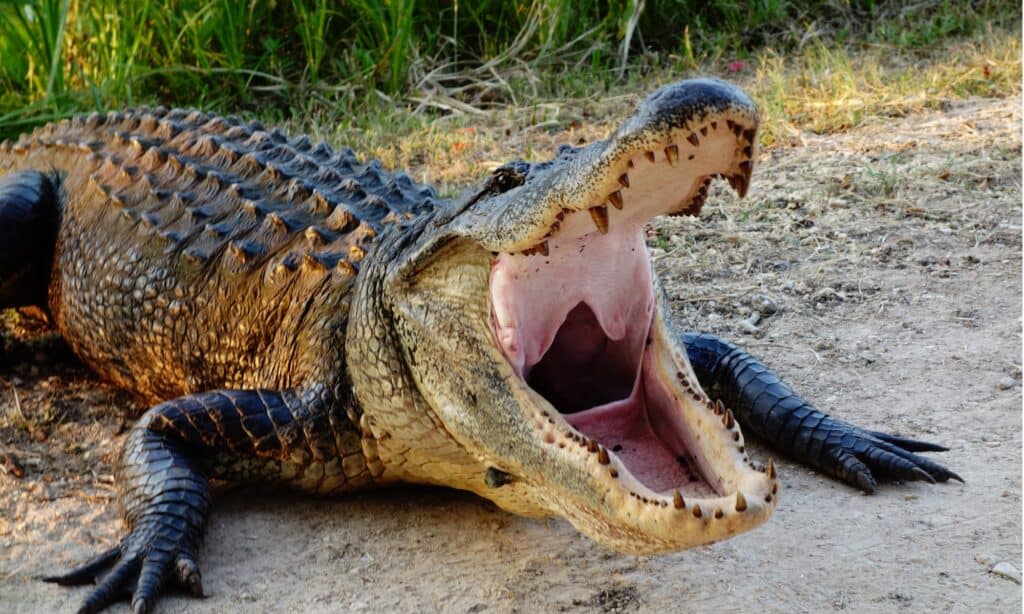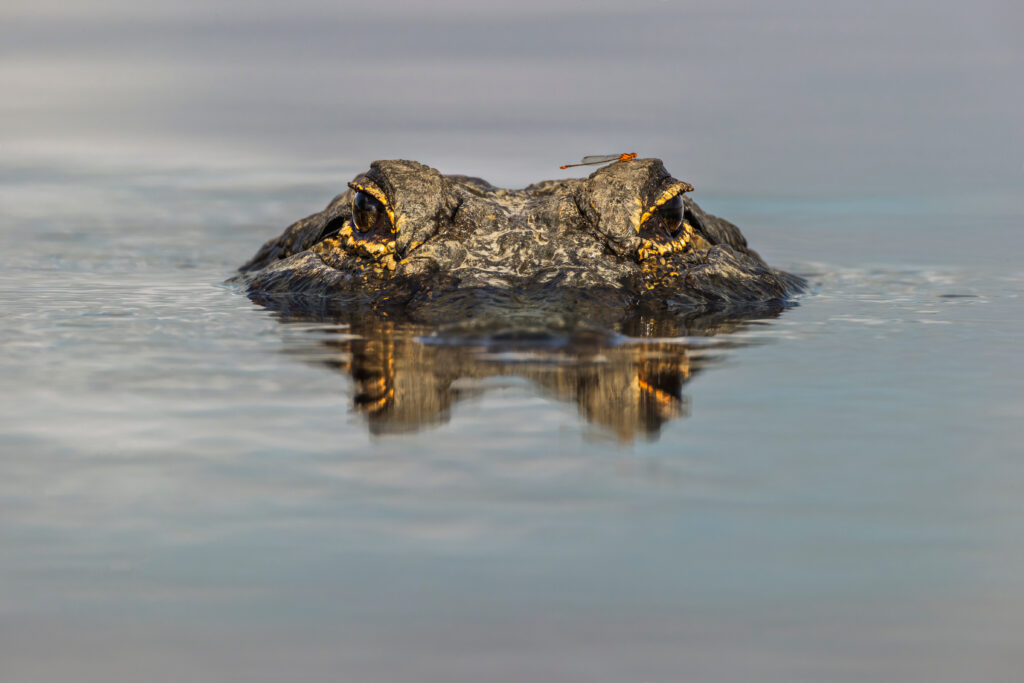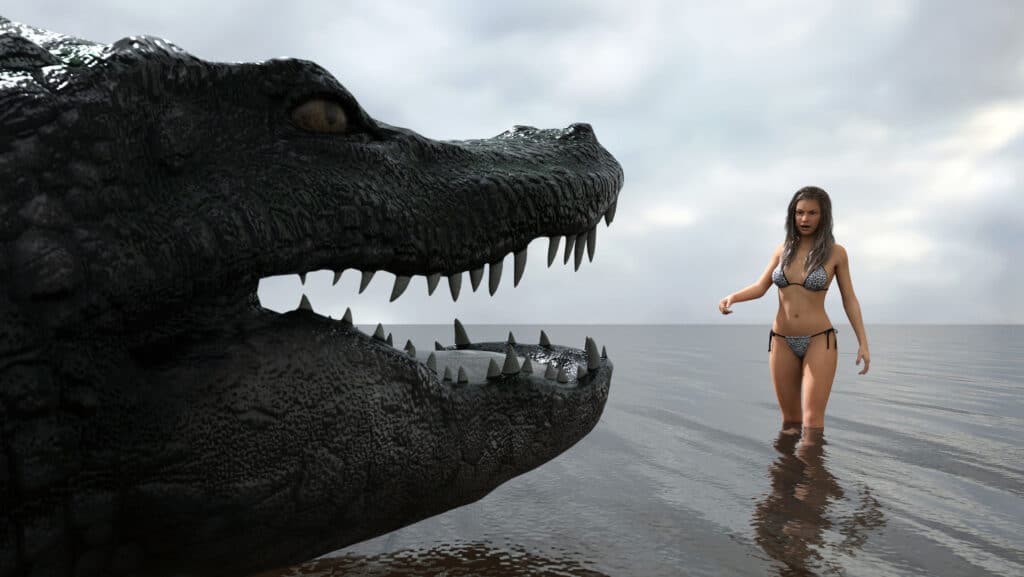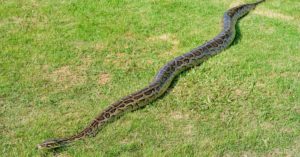Imagine taking a leisurely stroll by a lake in Jackson, Mississippi, only to spot an alligator basking in the sun nearby. The thought might make your heart race, but it’s important to remember that alligators are an essential part of our local ecosystem.
In this article, we’ll delve into the fascinating world of alligators in Jackson, exploring their history, population, behavior, and the challenges they face. We’ll also discuss the role of local authorities in managing alligator populations and share safety precautions and tips for residents living alongside these incredible creatures.
History of Alligators in Jackson

Once seen primarily as dangerous creatures, alligators are now increasingly recognized for their essential role in the ecosystem.
©iStock.com/Alex Pankratov
Let’s take a step back in time and discover the intriguing history of alligators in Jackson.
By understanding their past, we can better appreciate their presence in our local waterways today. From early records to recent population trends, we’ll explore how our relationship with these ancient reptiles has evolved over time.
Early Records
The history of alligators in Jackson, Mississippi goes back centuries, with indigenous peoples coexisting alongside these fascinating creatures. These indigenous populations regarded alligators highly, often featuring them in their art, mythology, and cultural practices. As European settlers arrived, alligators played a significant role in the area’s ecology and economy.
Changing Public Perception
Alligators have left their mark on Jackson’s history through various events and incidents. From headline-making encounters to their role in shaping local wildlife management policies, alligators have always been a vital part of the area’s unique story.
The public’s perception of alligators in Jackson has also evolved over time. Once seen primarily as dangerous creatures, alligators are now increasingly recognized for their essential role in the ecosystem. As we continue to learn about these creatures, our understanding and appreciation for them grow, helping us coexist harmoniously in our shared environment.
Alligator Population in Jackson

Alligators’ adaptability has allowed them to thrive in various habitats throughout Jackson.
©Danita Delimont/Shutterstock.com
The alligator population in Jackson has seen its ups and downs throughout history. Overhunting and habitat loss in the early 20th century led to a significant decline in their numbers. But thanks to conservation efforts and legal protection, the alligator population has rebounded, and these majestic animals are now thriving in local waterways once again.
Historical Perspective
Over the years, the alligator population in Jackson has experienced some notable fluctuations. As mentioned, conservation efforts and legal protection helped revive the once-declining population. These measures and the alligators’ adaptability has allowed them to thrive in various habitats throughout Jackson.
Current Population Estimates
Today, it’s estimated that thousands of American alligators, known scientifically as Alligator mississippiensis, call Jackson their home. They can be found in various water bodies, including rivers, lakes, swamps, and marshes. Their preferred habitats often include shallow waters with abundant vegetation, providing them with both food and cover.
Factors Contributing to Increased Sightings
Several factors have contributed to the rise in alligator sightings in Jackson. Urban development and habitat encroachment have brought alligators and humans closer together, making encounters more likely. Additionally, warmer temperatures and an increase in available food sources, such as fish and smaller reptiles, have supported the growth of the alligator population. Public awareness and more frequent reporting of sightings have also played a role in the perceived increase in alligator numbers.
Alligator Behavior and Human Encounters

Most attacks result from people inadvertently entering an alligator’s territory. Understanding and respecting their habitat is crucial for safety.
©Joeprachatree/Shutterstock.com
Understanding alligator behavior is vital to assessing the risks associated with human encounters and taking appropriate precautions. Let’s explore typical alligator behavior in the wild and discuss the factors that can influence their aggression towards humans.
Typical Alligator Behavior
In their natural environment, alligators are generally shy, elusive creatures that prefer to avoid humans. In addition, they are primarily nocturnal, spending most of their day basking in the sun to regulate their body temperature.
Alligators are opportunistic predators, feeding on a variety of prey, including fish, birds, and small mammals. While they can move quickly in short bursts, they are not built for sustained high-speed pursuits, and they often rely on stealth and ambush tactics to capture their prey.
Factors Influencing Aggression
Alligator aggression toward humans is relatively rare, but certain factors can increase the likelihood of an attack. These factors include:
- The alligator’s size and age. Larger and older alligators are more prone to aggression.
- Their past interaction with humans. Alligators that humans have fed may lose their natural fear and become more dangerous.
- The specific season. The breeding season can also influence alligator aggression, with both males and females being more territorial and protective during this time.
Statistics on Alligator Attacks
While alligator attacks on humans are relatively rare, it’s essential to be aware of the risks. In Jackson and the surrounding areas, alligator attacks have occurred, but they remain infrequent compared to other regions where alligators are more prevalent. Most attacks result from people inadvertently entering an alligator’s territory. Understanding and respecting their habitat is crucial for safety.
Comparison with Alligator Attack Rates in Other Regions
When comparing alligator attack rates in Jackson with those in other regions, it’s evident that the risk is relatively low. States like Florida and Louisiana, with larger alligator populations and more extensive wetland habitats, tend to have higher rates of alligator attacks. But even in those regions, alligator attacks are still relatively rare.
Alligator Management
As we’ve seen, alligators are an important part of the Jackson ecosystem. To ensure their safety and maintain a harmonious relationship between alligators and humans, local authorities have implemented various management strategies. Let’s discuss the role of these authorities and the measures they take to manage alligator populations effectively.
Role of Local Authorities
Local authorities, such as the Department of Wildlife, Fisheries, & Parks, are crucial in managing alligator populations in Jackson. They’re responsible for implementing conservation measures, monitoring alligator numbers, and enforcing regulations designed to protect alligators and their habitats.
Population Monitoring and Strategies
One of the key tasks of local authorities is to monitor alligator populations regularly. They use various methods to track alligator numbers and assess their overall health. They include aerial surveys and night-time spotlight counts. Based on this data, they implement management strategies, such as habitat restoration and controlled hunting, to ensure that alligator populations remain stable and sustainable.
Nuisance Alligators
Local authorities are also responsible for addressing situations involving nuisance alligators, which are those that pose a threat to human safety or property. In such cases, they may remove the alligator and relocate it to a more suitable habitat or, in some instances, euthanize the animal if deemed necessary.
They also work to educate the public on minimizing the potential for conflicts with alligators. They warn against feeding them and encourage proper disposal of food waste.
Public Education
Education and outreach are vital components of alligator management efforts in Jackson. Local authorities organize various programs and initiatives designed to raise awareness about alligators, their ecological importance, and how to coexist safely with them. By educating the public and fostering a greater understanding of alligators, local authorities can help ensure a harmonious relationship between humans and these grand reptiles.
Collaboration
Finally, local authorities often collaborate with other organizations and stakeholders to develop and implement effective alligator management strategies. They include wildlife researchers, non-profit organizations, and community groups. This collaborative approach ensures that all parties are working together to protect alligators and maintain a healthy ecosystem in Jackson.
Can You Coexist Safely With Alligators?

As a general rule, stay at least 30 feet away from them, whether you’re observing them in the wild or encountering them in your backyard.
©iStock.com/Cindy Larson
Living near alligators can be both fascinating and concerning. To ensure your safety and minimize the potential for conflicts, it’s important to follow certain precautions and be aware of best practices when it comes to interacting with alligators.
Avoid Feeding
One of the most crucial safety tips is to never feed alligators. Feeding them not only disrupts their natural feeding habits but also makes them less fearful of humans, increasing the likelihood of dangerous encounters. It’s also illegal in many areas, including Jackson, to feed alligators.
Keep a Safe Distance
Maintaining a safe distance from alligators is essential. As a general rule, stay at least 30 feet away from them, whether you’re observing them in the wild or encountering them in your backyard. If an alligator approaches you, back away slowly and give it plenty of space.
Be Extra Cautious During Breeding Season
As mentioned earlier, alligators can be more aggressive during the breeding season, so it’s important to exercise extra caution during this time. Be aware of your surroundings and avoid entering areas where alligators may be nesting or protecting their young.
Supervise Children and Pets
Alligators are often found near water, so always supervise children and pets when playing near lakes, rivers, or other water bodies where alligators may be present. Teach children to respect alligator habitats and never approach these animals.
Secure Your Property
To discourage alligators from entering your property, install fences and barriers around your yard, especially if you live near a body of water. Also, properly secure and dispose of food waste, as the smell can attract alligators.
Know Who to Call in Case of an Encounter
Finally, it’s essential to know who to contact if you encounter a potentially dangerous alligator or one that threatens human safety. Familiarize yourself with local authorities’ contact information, such as the Department of Wildlife, Fisheries, & Parks, and report any concerning alligator sightings.
Are You Safe to Go in the Water?
With all this information about alligators in Jackson, you might be wondering if it’s safe to go in the water. While alligator encounters in water are relatively rare, it’s essential to understand the risks and take appropriate precautions.
Assessing the Risk
First and foremost, alligators are naturally wary of humans and typically try to avoid us. But they may be more likely to approach if humans have fed them in the past or if they feel threatened. To assess the risk of an alligator encounter, consider factors like the time of day, location, and recent alligator activity in the area.
Alligators are most active between dusk and dawn, so swimming during these hours may pose a higher risk. Additionally, be cautious in areas with dense vegetation, as alligators may be hiding nearby.
Tips for Swimming Safely
If you decide to swim or recreate in an area with alligators, follow these tips to minimize the potential for conflicts:
- Swim in designated areas. Choose areas specifically designated for swimming, as local authorities are more likely to monitor and manage alligator populations in these locations.
- Avoid swimming alone. Alligators are less likely to approach a group of people, so swimming with others can help deter them.
- Stay aware of your surroundings. Be vigilant and keep an eye out for alligators, especially near the water’s edge.
- Don’t wear flashy jewelry or brightly colored clothing. These items can attract alligators, as they might mistake them for prey.
- Avoid splashing. Splashing can mimic the movements of prey, potentially attracting alligators.
Recognizing Warning Signs
If you’re in the water and notice an alligator nearby, look for warning signs of aggressive behavior. If the alligator hisses, growls, or starts swimming toward you, leave the water immediately and calmly. It’s important not to panic or make sudden movements, as this may further provoke the alligator.
Key Takeaways
While there is some risk associated with alligators in Jackson waters, being aware and informed can make a world of difference in ensuring your safety. Remember, personal responsibility and awareness are crucial when it comes to coexisting with these incredible creatures.
By respecting their habitat and boundaries, we can all enjoy the outdoors without fear. So, go ahead, take a dip, cast a line, or embark on a boating adventure in Jackson’s waterways. Stay informed and alert, and you’ll have a fantastic time, alligator-safe and sound!
The photo featured at the top of this post is © David Louis Tiffany/Shutterstock.com
Thank you for reading! Have some feedback for us? Contact the AZ Animals editorial team.







